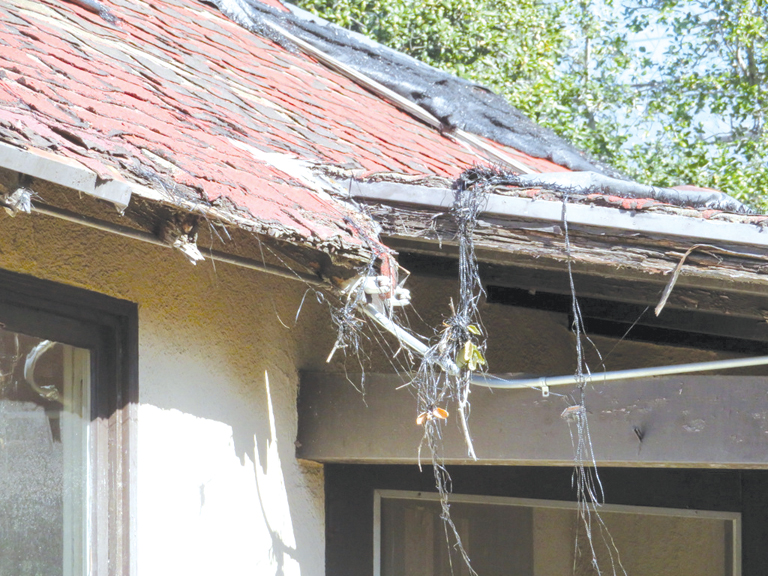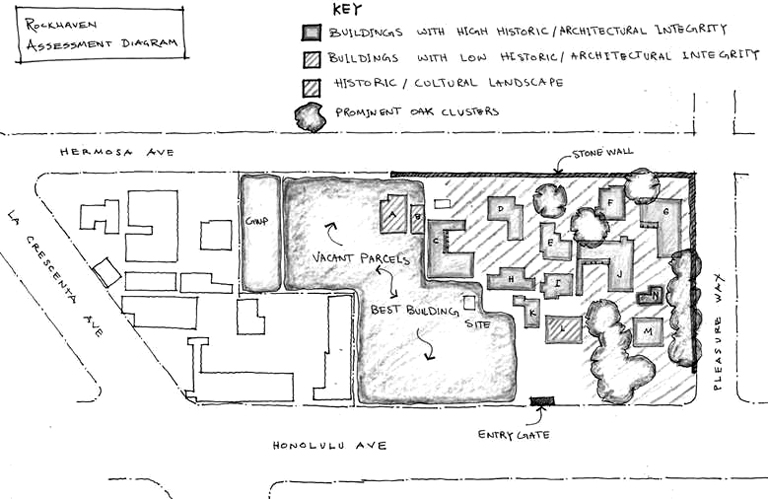The historic property began as a vibrant haven for troubled women but is now in a state of disrepair.

Rotting roofs are one sign of the deterioration of the Rockhaven property.
By Charly SHELTON
Rockhaven. No property in the Crescenta Valley sparks more discussion or controversy over its proper use. This week, we begin a two-part series looking deeply into Rockhaven Sanitarium – its history, what is the current status and what the future may hold.
For those unfamiliar, Rockhaven Sanitarium is a historic property in Montrose. Set far back behind wrought iron gates and high brick walls along Honolulu Avenue stands a collection of buildings, mature oaks and manicured gardens. These 3.5 acres housed Rockhaven Sanitarium, the hideaway in the hills for women, run by women. Registered nurse Agnes Richards founded Rockhaven in 1923 as a safe space for women to recuperate from a variety of maladies. Just three years after women won the right to vote, times were challenging for businesswomen in a man’s world.
Wives were sometimes committed to asylums by their husbands for any reason, their “illness” often listed as “hysteria.” These women were many times subjected to abuse by the staff at largely male-run sanitariums. Richards founded the sanitarium for women so they could get the help they needed without many of the downsides found elsewhere. And with an all-female staff, career opportunities were open to women.
The sanitarium served many Hollywood notables such as Gladys Pearl Eley Baker, the mother of Marilyn Monroe, Billie Burke, known for playing Glinda the Good Witch in “The Wizard of Oz,” Josephine Dillon, famed acting teacher and ex-wife of Clark Gable, and more. Richards operated the sanitarium from 1923 until 1967 when she passed it on to her granddaughter, Patricia Traviss. Traviss operated Rockhaven from 1967 until 2001, selling it to a large hospital corporation, The Ararat Company. In 2006, Rockhaven was closed due to lack of profitability, with the intent of demolishing the buildings to build a more modern structure.
The City of Glendale purchased Rockhaven in April 2008.
“The City acquired it to protect the historic nature of the site, and preserve the site, or portions of it, as public community space,” said Eliza Papazian, public information officer for the City of Glendale. “The drain on economic resources since the City’s acquisition of the site coupled with the state’s elimination of redevelopment made eventual development of the Rockhaven site challenging. The City’s ability to wholly finance development of the site as a capital improvement project has been severely curtailed.”
Under the City’s tenure, and with help from organizations like Friends of Rockhaven, the site has been relatively untouched ever since. That is both a good and a bad thing, in that the site has not been touched for development but it also has not been touched for upkeep, other than the limited upkeep that is provided by volunteers.
Reports flood in from concerned community members about the deterioration being observed from the outside of the facility and reported by those who visit the inside. CV Weekly has published numerous stories on the lack of maintenance at Rockhaven, some as recently as February of this year, and they can be found on the newspaper’s website.

“The City has generally maintained the site improvements by hand watering and pruning vegetation, cleaning debris, trimming trees, inspecting for termites, tarping roofs, improving perimeter security fencing, installing a backflow prevention device and above-ground irrigation pipes, and upgrading some electrical,” Papazian said. “The City has also made some renovations to the caretaker’s house.”
This is true in that the gardens do look maintained, no major vegetation is left dead and lying around, and it hasn’t flooded from burst pipes. These issues are not the ones being cited as problematic, though. What is troublesome to passersby is that the fence is falling down on one side of the property and is not being repaired, only patched with plywood, which causes more damage. The roof is in shambles with shingles sliding apart and allowing water inside the structures, making the ceilings peel and fall in places. In some places, plywood is blocking doors and shutting off entire rooms.
Joanna Linkchorst is the president of Friends of Rockhaven and a major proponent of restoring Rockhaven. She has been working to catalogue some of the artifacts left within the buildings and wants them properly preserved. She would go in and work with the artifacts when nobody else was using the property. One day, Linkchorst said, a program training police dogs had left hair and trash in a room with artifacts. She told the City that it’s not good for the buildings to leave trash and hair, and maybe the dogs should train outside the buildings. The City reportedly agreed and said nobody would go in the buildings again … including Linkchorst. Then later a distinction was made to her that it was unsafe to enter this particular building.
“I have a feeling that, four years ago, somebody said, ‘You’re not allowed up there’ and somebody translated that into ‘It’s not safe,’ which isn’t true,” Linkchorst said. “So the lower half of that door is boarded up [with plywood] and now they think it’s unsafe.”
Regardless, Rockhaven cannot sit with falling ceilings and unsafe rooms boarded up. Rockhaven has the distinction of being placed on the National Register of Historic Places at the state level as a Historic District, which grants certain protections to it and requires the owner to maintain it in certain ways.
Next week, we will unpack what all that means, how it is supposed to be maintained and where Rockhaven is headed.
